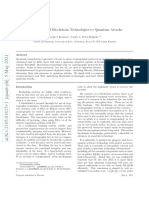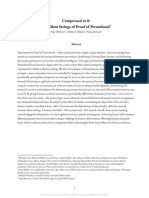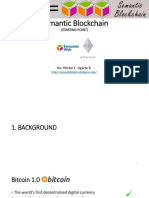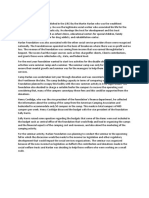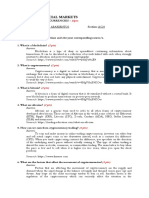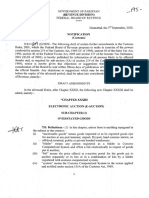Demystifying Stablecoins
Uploaded by
xiaohe123410Demystifying Stablecoins
Uploaded by
xiaohe123410SoK: Demystifying Stablecoins∗
JEREMY CLARK, Concordia University
DIDEM DEMIRAG, Concordia University
SEYEDEHMAHSA MOOSAVI, Concordia University
Stablecoins promise the functionality of Bitcoin without the rollercoaster ride of its exchange rate. But can this new breed of
cryptocurrency really outsmart decades of central bank policy with algorithms and smart contracts?
1 INTRODUCTION
The first wave of cryptocurrencies, starting in the 1980s, attempted to provide a digitization of government-issued
currency (or ‘fiat currency’ as cryptocurrency enthusiasts say) [9]. The second wave, represented prominently by
Bitcoin [8], provide their own separate currency — issued and operated independently of any existing currencies,
governments, or financial institutions. Bitcoin’s currency (BTC) is issued in fixed quantities according to a
hardcoded schedule in the protocol.
In the words of Bitcoin’s pseudonymous inventor, “there is nobody to act as a central bank. . . to adjust the money
supply. . . that would have required a trusted party to determine the value because I don’t know a way for software to
know the real world value of things. If there was some clever way, or if we wanted to trust someone to actively manage
the money supply to peg it to something, the rules could have been programmed for that. In this sense, it’s more
typical of a precious metal. Instead of the supply changing to keep the value the same, the supply is predetermined
and the value changes” [2].
Without active management, the exchange rate of BTC with governmental currencies has been marked by
extreme volatility (see Figure 1). Squint at the chart to notice how the GBP drops around June 2016: this mild-
looking pinch is actually the ‘sharp decline’ and ‘severe swing’ that followed the Brexit referendum in the UK.
However, it is completely overshadowed when placed beside BTC’s large fluctuations.
A third wave? Extreme volatility is not specific to Bitcoin (BTC), and can also be seen in its contemporaries
Ethereum (ETH) and Ripple (XRP). This instability is an issue of practical importance: volatility encourages users
to hoard (if it is going up) or avoid (if it is going down) the currency rather than use it. It makes lending risky, as
currency movements can exceed interest payments. A lack of lending and credit inhibits the formation of mature
financial markets. In response, a flood of proposals have been made for new cryptocurrency designs that purport
to provide a stable exchange rate similar to (or exactly mirroring) a government-issued currency like the USD.
These designs are called stablecoins.
Stablecoins have garnered a lot of attention recently, both positive and negative. According to CoinMarketCap,
more value in Tether changes hands across a given day than Bitcoin. This despite questions about Tether’s reserves
and regulatory investigations into its affiliates. The announcement of Facebook’s Libra made international
headlines and has been remarked on by the Fed, US legislators, and the even the sitting President. Another
project, Basis (née Basecoin) raised $133M in Venture Capital but folded up when it could not find a tenable path
through US financial regulations. Central banks, including those of Sweden and Denmark, have explored the idea
of government-issued stable cryptocurrencies.
Knowledge gap. Understanding how stablecoins work should be easy. Most firms/projects have a whitepaper
outlining the design, the coins are marketed to the general public, and there is no shortage of online articles
surveying various designs. Unfortunately there are a number of pitfalls in systemizing this knowledge. Many
∗ Thisdraft is an author’s preprint of [3] with a full appendix. Authors listed alphabetically. D. Demirag and S. Moosavi should be considered
equal first authors.
, Vol. 1, No. 1, Article . Publication date: April 2020.
Electronic copy available at: https://ssrn.com/abstract=3466371
Comparison of Currencies
20
15
EUR
CAD
USD
10
GBP
mBTC
0
2016 2017 2018 2019
Fig. 1. Comparison among fiat currencies and Bitcoin: The values are retrieved daily between 01 Jan 2016 and 01 Jan 2019.
Note that 1000 mBTC = 1 BTC.
whitepapers are obfuscated with jargon—terms left undefined and/or used inconsistently with other projects
and with the financial literature. In other cases, system components appear to be mislabeled. For example, a
component that cleanly meets the definition of a security or a derivative might instead be labeled a bond or a
loan. Maybe this is a lack of precision, or maybe it is a play to make an unconventional protocol appear more
conventional? Or maybe they are unconscious attempts at keeping any regulatory red flags at half mast? In any
case, we made a concentrated effort to offer direct and simple explanations (see Table 2). In parallel to our work,
other academics have produced their own taxonomies [7, 11].
Sidebar
Prices. A cryptocurrency (like any asset) has two prices: (1) the most someone is willing to pay and (2) the
least someone is willing to sell for. These are referred to as the best bid price and best offer (or ask) price
respectively. Note that the best bid price should logically be less than the best offer price, otherwise an
exchange would happen (such prices might occasionally ‘cross’ but this should be temporal and quickly
resolved with an exchange). Say a stablecoin is designed to ensure one unit is always priced at $1 USD. To
argue stability, one must show both that (1) the bid price should never exceed $1 USD and (2) the offer price
should never dip below $1 USD. Note, conversely, that bids can dip below $1 USD (everyone prefers to pay
less than something is worth) and asks can exceed $1 USD (everyone prefers to receive more than
something is worth).
Electronic copy available at: https://ssrn.com/abstract=3466371
Sidebar
Bitcoin & Blockchain Primer. A public blockchain is a type of distributed database (or ledger) that is
open to anyone who wants to maintain it, robust against faulty and malicious participants, and runs without
anyone in charge. When a participant looks at her local copy of the ledger, she is assured that (1) everyone
has the exact same records and (2) each record was validated by the majority of participants before it was
written into the ledger. Bitcoin is a digital currency that introduced the idea of a blockchain to track how
much BTC is held by each account, and to write ‘smart’ transactions for BTC payments. Transactions are
added to the blockchain in a batch (called a block) by a network participant (called a miner) and miners
include a special transaction that pays themselves newly minted BTC (called a coinbase transaction). The
amount of new BTC released to miners follows a schedule built into the protocol and will decrement over
time, eventually reaching zero once a determined amount of BTC has been made available.
Sidebar
Ethereum & DApp Primer. Ethereum is a blockchain protocol with a BTC-esque cryptocurrency called
Ether (ETH). To a degree much greater than Bitcoin, Ethereum allows users to code verbose ‘smart
contracts’ or ‘decentralized apps (DApps)’ that can be stored on the blockchain (for a fee). Once a DApp is
deployed, users can run its functions (again, for a fee). The functions are executed by the miners and the
output is written to the blockchain. Among other things, DApps can hold ETH and write functions that
define how the ETH will be transferred from the DApp. DApps can also create their own currencies and
circulate them as tokens. ERC20 tokens are compliant with a widely used Ethereum standard and can
interoperate with existing wallet software, web-based exchanges, and token-tracking websites.
2 HOW DO STABLECOINS WORK?
We started by finding stablecoin projects on CoinDesk, an online news source for cryptocurrencies, using search
queries like “stablecoins,” “stability,” and “price-stable.” We read 185 articles up to January 11, 2019.1 For the 25
projects for which we could find sufficient documentation, we classified them in Table 1. This classification is
done according to what the projects assert they do—we provide no warranty of what the projects do in reality.
We sort projects according to their rank on CoinMarketCap which ranks cryptocurrencies that are actively traded
on an exchange service. Unlisted projects are ranked ⊥.
Next, we distilled each proposal into a core stability mechanism. Instead of enumerating the intricate details of
how each ‘brand’ of stablecoin works—details that could change tomorrow—we concentrate on communicating
the fundamentals. Broadly, the proposals can be split into two categories: (1) ones that try to directly match the
stability of a second asset, such as the USD, and could not exist without this underlying asset, and (2) ones that
propose independent currencies with algorithmic and/or human intervention mechanisms for providing stability.
Fuller detail is provided in Table 2.
1 Given its high profile, we also include Facebook’s Libra Coin which was released after this date.
Electronic copy available at: https://ssrn.com/abstract=3466371
Class Mechanism Resembles Rank
USDC 20
TrueUSD 26
Paxos 38
Gemini Dollar 52
Directly-Backed & Redeemable†
StableUSD (USDS) 685
Stronghold USD 891
Petro 1210
Libra Coin, Ekon, WBTC, emparta ⊥
Backed Tether 6
EURSToken 95
BitCNY 304
Directly-Backed
Terracoin 1280
Saga 1495
GJY, Novatti AUD, UPUSD ⊥
Dai 57
Indirectly-Backed BitUSD 398
Nomin ⊥
Ampleforth ⊥
Money Supply Adjustments
RSCoin ⊥
Intervention NuBits 892
Asset Transfer
CarbonUSD 1262
Basecoin ⊥
Table 1. Stablecoin proposals as of January 11, 2019. † Disclaimer: Projects are classified according to what they assert; e.g.,
we provide no warranty that projects classified as ‘redeemable’ provide actual redemption of the assets that back their coins.
Rank corresponds to CoinMarketCap.
3 TYPE 1: BACKED STABLECOINS
3.1 Directly-Backed and Redeemable
For stablecoins in this category, the firm operating the currency will obtain a reserve of some valuable asset—it
might be USD or another sovereign currency, gold or another commodity, or a basket of multiple assets. It will
then issue digital tokens that represent a unit of the underlying asset (to illustrate, assume a token is redeemable
for 1 USD) which can be exchanged online.
This idea predates Bitcoin: Liberty Reserve provided a similar digital currency, with some caveats about its
redeemability (not to mention its legality). However Liberty Reserve, e-gold, and similar pre-blockchain services
would maintain transaction details and account balances on a private server. Blockchain enables decentralized
trust for the transactions, while the coin creation and redemption processes rely on a trustworthy firm. In short,
this type of stablecoin is more centralized than Bitcoin but less than Liberty Reserve. For analysis, we need a
finer grained approach to trust assumptions which Table 3 tries to capture. Also consider that while decreasing
centralization can be good for trust and transparency, additional measures are needed to ensure it is not harmful
for privacy.
Recall the mechanism for issuing AliceCoins in Table 2. If buyers are willing to pay more than $1 USD for 1
AliceCoin, new coins can be generated for $1 USD and sold to these buyers for a profit, ensuring bids return to $1
USD (it corrects overvaluation). If sellers are willing to take less than $1 USD for 1 AliceCoin, these coins can
Electronic copy available at: https://ssrn.com/abstract=3466371
Stability Mechanisms
Directly Backed and Redeemable.
Alice is a trusted third party and uses Ethereum to instantiate a decentralized application (DApp) which issues 1000 AliceCoins as standard
tokens (e.g., ERC20). She asks $1 USD for 1 AliceCoin and promises to redeem any AliceCoin for $1 USD. If Bob buys 10 AliceCoins for $10
USD, Alice deposits the $10 USD in a bank account. Any time Alice receives a buy order for AliceCoins and does not have any left to sell, she
creates new ones to sell. If Carol wants to redeem 5 AliceCoins, Alice withdraws $5 USD and exchanges it with Carol, taking those AliceCoins
out of circulation. Alice frequently publishes bank statements showing that her account holds enough USD to redeem all coins in circulation
(the number of AliceCoins can be checked anytime on Ethereum).
Directly Backed.
Again, Alice is a trusted third party that issues 1000 AliceCoins as ERC20 tokens. She asks $1 USD for 1 AliceCoin and promises to deposit
and hold the payment in a bank account. As before, Alice creates new AliceCoins when she runs out and publishes frequent bank statements.
Unlike above, she offers no direct redemption of AliceCoins for USD.
Indirectly Backed.
Alice is no longer assumed to be trustworthy. She sets up a DApp that can hold ETH and issue tokens. The DApp determines how much ETH
is equivalent to $1.50 USD using the current exchange rate, provided to the DApp by a trusted third party oracle, and Alice deposits this
amount of ETH into the DApp. The DApp issues to Alice two places in a line — each place is a transferrable token. At some future time, the
holder of the first place in line can redeem up to $1.00 USD worth of the deposited ETH at the going exchange rate, and the holder of the
second place in line gets any remaining ETH. Alice will transfer the first place in line (as a stable coin called AliceCoin) to Bob for $1.00 USD,
and will hold or sell the second place in line. When Bob redeems the AliceCoin, it will be worth $1 USD in ETH when the entire deposit of
ETH is worth more than $1 USD. If the exchange rate drops enough, the entire deposit will be worth less than $1 USD — Bob will get all of
the deposit and the holder of the second place in line will get nothing.
Money Supply Adjustments.
Alice forks Bitcoin to create a new altcoin called AliceCoin. She tweaks the schedule for releasing new AliceCoins (called the coinbase amount
in Bitcoin) according to the rules outlined below. She sets up a trusted oracle for the latest exchange rate of AliceCoins to USD. AliceCoin is
programmed to apply an intervention when the price of an AliceCoin exceeds $1.02 USD or dips below $0.98 USD. If the price exceeds $1.02
USD, the miner is allowed to increase the coinbase amount (the amount is determined by some mathematical relationship with how much the
price exceeds $1.02 USD). If the price dips under $0.98 USD, the miner must decrease the coinbase amount based on the same relationship.
The correctness of the claimed coinbase is verified by other miners in deciding to accept or reject a mined block, as per all other checked
conditions in Bitcoin.
Asset Transfer.
Alice instantiates a DApp with an ERC20 token called AliceCoin. The DApp is programmed to apply an intervention when the price of an
AliceCoin exceeds $1.02 USD or dips below $0.98 USD according to a trusted oracle. If the price exceeds $1.02 USD, the DApp creates new a
set of AliceCoins (as above, according to some mathematical relationship) and transfers them to users waiting in line for them. How do users
wait in line? When the price dips under $0.98 USD, the DApp creates new positions at the end of the line and auctions them off to the highest
bidder. The payment for a place in line is made in AliceCoins from the bidder to the DApp and the DApp destroys the payment. The place in
line is a transferrable token. If the line is empty, AliceCoins are distributed according to a fallback policy (see main text).
Table 2. Major types of stability mechanisms for stablecoins.
be bought and redeemed for a profit, ensuring offers return to $1 USD (it corrects undervaluation). In reality,
transactions are not free, efficient, or entirely frictionless and some price deviation is expected. If redemption is
ever in doubt, then the price can fall freely from $1 USD (although this will not necessary happen, see next section).
The trustworthiness of the operating firm and the custodian of the reserves is essential, and financial audits
are an important step to establishing confidence (although many pitfalls exist when auditing blockchain-based
assets [12]).
3.2 Directly-Backed
What if a stablecoin operated exactly as in the previous section but did not offer a redemption process for the
coin’s underlying assets? If we could not find a clear assertion of redemption, we listed the project under this
category in Table 1.
Electronic copy available at: https://ssrn.com/abstract=3466371
An sted o ansfe n
ion
tio
n
Dec ralize suance
r
No tralize demp
Dec ralize luatio
Dec ts ove aluat
le
er v
re
r va
s tr
is
rac
ven vel
s
s
Cor ts und
An rice le
t
An set
ent
ent
s
rec
rec
tru
en
yp
ya
ye
Cor
Mechanism Price Trust Target
Traditional Digital Cash • • • •
Traditional Cryptocurrency • × • •
Directly Backed and Redeemable • • • • •
Directly Backed • • • •
Indirectly Backed ◦ • • • • • •
Money Supply Adjustments ? ◦ • × • ◦ • • •
Asset Transfer ? ◦ • × • ◦ • • •
Table 3. Comparative evaluation of mechanisms to design stablecoins: • indicates the properties (columns) are fulfilled by
the corresponding mechanism (rows) within reason, ◦ means the property is fulfilled but the fulfillment is bounded, ?
indicates a heuristic has been proposed for stability and the conditions under which it will work are not well-established
enough to evaluate, and × indicates the property is not applicable. Price and trust are explained in the main text and target
is explained in Appendix B.1.
Recall the mechanism in Table 2. Bids will not exceed $1 for the same reason as the previous section. However
there is no longer a way to profit if offers vary between $0 USD to $1 USD (i.e., the mechanism does not prevent
undervaluation). Generally coins in this category are in fact ‘redeemable’ by one user: the firm operating the
coin. It could purchase undervalued coins to release $1 USD from its reserves. For this reason, stablecoins in this
category are scrutinized (to the extent made possible by the firm) to ensure reserves are intact. If every AliceCoin
was not backed by $1 USD, Alice could overissue AliceCoins to enrich herself.
The largest coin is this category is Tether. Tether claims to be redeemable, but the redemption process is
reported by users to have a lot of friction, it is accused of issuing coins to manipulate markets [5], and it has not
always maintained full reserves of USD to allow all Tether to be redeemed (for these reasons, we categorize it
here). To many, it is a mystery why Tether remains highly liquid with daily trading volumes exceeding all other
cryptocurrencies in value (according to CoinMarketCap at the time of writing). One explanation is that it is too
useful to fail.
A key use-case, illustrated by Tether and the affiliated exchange Bitfinex, is as a temporary store of value for
traders and speculators. A trader that wants to divest their BTC for USD has three options. She can (1) hold the
USD in her exchange account, which can be used only on the same exchange and requires the exchange to be a
trustworthy custodian. She can (2) withdraw the USD from the exchange but this requires identity verification
(in most jurisdictions), a bank that will accept proceeds of cryptocurrency trading, and a substantial time delay.
A balanced alternative is to (3) exchange BTC into a stablecoin which can be withdrawn from the exchange
(i.e., moved from the exchange to Alice’s private key) with little friction, delay, or regulatory oversight. The
withdrawn stablecoin can be moved onto a different exchange, transferred to other users, or used for direct
purchases without involving the original exchange. In short, it offers more flexibility than leaving USD in an
exchange account and less friction than withdrawing USD.
Electronic copy available at: https://ssrn.com/abstract=3466371
3.3 Indirectly-Backed
Both of the previous mechanisms placed heavy trust assumptions on the firm operating the currency. Could a
currency be managed autonomously by a DApp? The key idea of this mechanism is to offer a redeemable token
that can be converted into $1 USD worth of ETH at the going USD/ETH exchange rate. Therefore the amount of
ETH received ETH will grow or shrink depending on the exchange rate. Because a blockchain has no inherent
knowledge of exchange rates, this mechanism still requires one trustworthy entity called an oracle to write the
exchange rate into the blockchain (or consensus can be taken across a set of oracles).
Recall the mechanism in Table 2. Bids for an AliceCoin in excess of $1 USD will be fulfilled as long as there
are individuals like Alice willing to lock up a deposit of ETH that is 1.5× the face-value of what they receive
(this is called over-collateralization). An AliceCoin offered for less than $1 USD can be purchased and redeemed
for a profit–assuming the DApp holds enough ETH. Otherwise, an AliceCoin will sell between $0 and $1 USD
according to the value of the ETH held by the DApp.
Is it risky for Alice to offer such an AliceCoin? Holding the second place in line is more volatile than holding
ETH itself—this stability mechanism does not (and cannot) eliminate volatility, it simply pushes it from the first
place to the second place in line. However the second place in line is never more than $1 USD short of the full
amount of ETH held in the DApp. So if Alice keeps the $1 USD she received for the AliceCoin, it offsets any
losses from the second place in line. She has no more risk than holding ETH. The second place in line can also be
sold to someone who is seeking risk: the token is a leveraged bet that ETH rises in value. Is it risky for Bob? In
most conditions, holding an AliceCoin is purposefully the same as holding USD. However if the USD/ETH rate
deteriorates quickly, the AliceCoin will use up its buffer and start to lose value (at the same rate as ETH).
Here are just a few of the design decisions to consider when deploying an indirectly-backed stablecoin: what
should the overcollateralization ratio be (e.g., 1.5x)? When can an AliceCoin be redeemed (e.g., on-demand, after
an elapsed time, after movements in USD/ETH, etc.)? How do you issue multiple AliceCoins (e.g., collateral for
each coin is held separately, or collateral for all coins are pooled together and coins are interchangeable)?
4 TYPE 2: INTERVENTION-BASED STABLECOINS
4.1 Money Supply Adjustments
A trusted oracle provides the going exchange rate between the cryptocurrency and a stable-valued asset, such as
the USD. When the cryptocurrency gains value, the supply of the cryptocurrency is increased, and when it loses
value, the supply is decreased. This mechanism is based on how central banks have historically controlled their
economies, however the specifics of exchange rate targetting have been abandoned by modern central banks
after past failures. That said, exchange rates are an illustrative example and other financial indicators could be
used: oracle-provided interest rates (should lending markets emerge) or purchasing power; on-blockchain metrics
like transaction volumes (should these prove robust against manipulation), or human discretion (such as central
banks themselves [4]).
Allowing a crypto-currency to expand is not difficult. Who receives the new currency is a design decision
with options including: (1) existing holders of the currency in proportion to their holdings, (2) existing holders
through a random lottery, (3) miners, or (4) a specific entity like a central bank. Who loses when the currency
contracts is the primary challenge.
The mechanism in Table 2 gives one illustration. Here if many bids for AliceCoin exceed $1.02 USD, some of
the newly injected currency could be spent on obtaining USD until all buyers willing to pay more than $1.02 USD
have purchased AliceCoins. This is merely a heuristical argument because there is no guarantee the recipients
will spend the new currency on USD, especially if demand for USD is falling. The justification for offers below
$0.98 is symmetric: the currency contractions could make holders less willing to spend it on USD. However if the
Electronic copy available at: https://ssrn.com/abstract=3466371
mBTC
●
● ●
●
1.●
●
●
● ●
●
● 0.8●
●
●
● ● CAD
●
● ● EUR
● ● 0.6
● TETHER
● ● ● ● BitUSD
●
● ● ● ●
0.4
● ●
● ●
●
●
● ●
●
0.2● ●
● ●● ● ●
●
● ●
●
● ● ●●
●● ●
● ● ● ● ● ● ●
●● ● ● ●
● ● ●● ●● ● ●●
● ● ● ● ●
● ● ● ● ● ● ●
● ●
Change in USD
- 0.05 + 0.05 + 0.1
Fig. 2. Volatility in prices for two fiat currencies (CAD and EUR) and two stablecoins (Tether and BitUSD) against the USD
and BTC. Vertical line segments demonstrate stability with the USD. Horizontal shows volatility in USD. For further
interpretation, see Appendix A.2. While CAD and EUR are not pegged to USD, they demonstrate a degree of stability not
that different from the stablecoins. Prices from Jan 2017 to Nov 2018; 1000 mBTC = 1 BTC.
price drop is caused by a lack of demand for AliceCoins rather than an oversupply, then removing supply will
only thin out the market but not actually incentivize traders to trade and correct the undervaluation.
When the coinbase is increased or decreased dynamically (called an elastic coinbase), increases can be by
any amount but decreases cannot appear to go past zero. When the coinbase is exactly zero, miners are still
incentivized to mine because of the fees provided in the transactions. In fact this is how Bitcoin will eventually
(projected to happen in 2140) function once all BTC is created (how well it will work is debatable [1]). Could the
coinbase go negative? Since miners are rewarded the sum of the coinbase and the transaction fees, a coinbase
can indeed be moderately negative if the transaction fees are greater than the negative coinbase. Under this
deployment, the users are effectively burning their transaction fees to contract the money supply.
4.2 Asset Transfer
The second subtype of intervention-based stability mechanism expands and contracts the supply of currency to
influence its value, however it uses a less direct contraction method. Recall the mechanism in Table 2. If many
bids in excess of $1.02 USD remain unexecuted, the logic follows the previous section: the currency is handed
out in hopes that more USD will be bought. The justification for offers below $0.98 is premised on individuals
buying places in line, and if this premise is true, the resulting contraction of the currency follows the same logic
as the previous section. The purchase of a spot in line is highly speculative — the currency might not return to
stability and the spot might never be reached. As the line gets longer, the price of a place in line will fall, and the
speculative market will thin out to traders wanting a higher and higher risk/reward ratio. These trends do not
guarantee, or even point toward, a recovery in price.
Electronic copy available at: https://ssrn.com/abstract=3466371
5 DISCUSSION AND CONCLUSION.
More details are available in the appendix. It includes more detail about each coin, some empirical studies of how
stable these coins are (see Figure 2 for a preview), and an evaluation of whether of Ethereum’s mechanism for
paying for computation (gas) is stable or not (the answer: it does not seem to be, for now).
In short, stablecoins might tokenize a low volatility coin and bring it onto the blockchain. Or they generally
play one of two tricks. The first trick is to expand and contract the amount of currency to stabilize the value. The
second trick is to turn two high volatility coins (e.g., of the underlying cryptocurrency) into one stablecoin and
one extremely volatile coin. This last trick is similar to other financial assets which do not reduce overall risk, but
instead push it from one tranche of the asset to another.
Why are there so many projects? The differentiation between coins is along a few parameters: (1) the type
of asset that can be redeemed for the coin: USD, EUR, gold, etc.; (2) the underlying blockchain (e.g., Bitcoin,
Ethereum, etc.) and the low-level technical design (updatable contracts, governance, etc.); and (3) the country it
operates from which determines the degree of regulatory compliance that’s required.
What’s next? Self-sovereign stablecoins are interesting and probably here to stay, however they face numerous
regulatory hurdles from banking, financial tracking, and (likely) securities laws. For stablecoins backed by a
governmental currency, the ultimate expression would be a centrally banked digital currency (CBDC). Since
paper currency has been in steady decline (and disproportionately for legitimate transactions [13]), a CBDC
could reintroduce cash with technological advantages and efficient settlement while minimizing user fees.
ACKNOWLEDGMENTS
J. Clark acknowledges support for this research project from the Autorité des Marchés Financiers (AMF) and from
the NSERC/RCGT/Catallaxy Industrial Research Chair in Blockchain Technologies. S. Moosavi acknowledges
support from The Fonds de recherche du Québec - Nature et technologies (FRQNT).
REFERENCES
[1] Miles Carlsten, Harry Kalodner, S Matthew Weinberg, and Arvind Narayanan. 2016. On the instability of bitcoin without the block
reward. In ACM CCS. ACM, 154–167.
[2] Phil Champagne. 2014. The book of Satoshi: The Collected Writings of Bitcoin Creator Satoshi Nakamoto. e53.
[3] Jeremy Clark, Didem Demirag, and Seyedehmahsa Moosavi. 2020. Demystifying Stablecoins. Commun. ACM (2020).
[4] George Danezis and Sarah Meiklejohn. 2016. Centrally banked cryptocurrencies. In NDSS.
[5] John M Griffin and Amin Shams. 2018. Is bitcoin really un-tethered? Available at SSRN 3195066 (2018).
[6] Larry Harris. 2003. Trading and exchanges: Market microstructure for practitioners. Oxford University Press, USA. 410–419 pages.
[7] Amani Moin, Kevin Sekniqi, and Emin Gun Sirer. 2020. SoK: A Classification Framework for Stablecoin Designs. In Financial Cryptogra-
phy.
[8] Satoshi Nakamoto et al. 2008. Bitcoin: A peer-to-peer electronic cash system. (2008).
[9] A Narayanan, J Bonneau, Edward W. Felten, Andrew Miller, and Steven Goldfeder. 2016. Bitcoin and Cryptocurrency Technologies.
Princeton.
[10] Mildred Chidinma Okoye and Jeremy Clark. 2018. Toward Cryptocurrency Lending. In International Conference on Financial Cryptography
and Data Security. Springer, 367–380.
[11] Ingolf G A Pernice, Sebastian Henningsen, Roman Proskalovich, Martin Florian, and Hermann Elendner. 2019. Monetary Stabilization
in Cryptocurrencies: Design Approaches and Open Questions. In CVCBT.
[12] Erica Pimentel, Emilio Boulianne, Shayan Eskandari, and Jeremy Clark. 2019. Systemizing the Challenges of Auditing Blockchain-Based
Assets. SSRN.
[13] Kenneth S Rogoff. 2017. The Curse of Cash: How Large-Denomination Bills Aid Crime and Tax Evasion and Constrain Monetary Policy.
Princeton University Press.
[14] Gavin Wood. 2014. Ethereum yellow paper. Internet: https://github. com/ethereum/yellowpaper,[Oct. 30, 2018] (2014).
Electronic copy available at: https://ssrn.com/abstract=3466371
A EXPANDED BACKGROUND
A.1 Prices
If 1 BTC is worth $3598.76 USD, as Google says it is at the time of writing, what does that actually mean? There
are several subtleties here: (1) what that price actually represents, (2) the relationship between a quoted price and
its actual price, (3) the concept that prices are really an exchange of one type of valuable good for another, and (4)
the distinction between something’s price and its value.
The quoted price means that two (hopefully different2 ) people recently exchanged BTC and USD at a valuation
of 1 BTC for $3598.76 USD. First, note that it does not necessarily mean that exactly 1 BTC was exchanged —
it could have been 1 mBTC for $3.60 or 1000 BTC for $36M USD. Further, this valuation on the previous trade
does not mean you will necessarily be able to exchange 1 BTC for $3598.76 USD. Last sale price is an indicator of
current price that becomes stale as time between subsequent exchanges increase (for example, for a house that
last sold 30 years ago, last sale price on a house is not a good indicator of current price).
Instead, we will use the idea of that a cryptocurrency (or any asset) has two prices: (1) the most someone
is willing to pay and (2) the least someone is willing to sell for. These are referred to as the best bid price and
best ask (or offer) price respectively. Note that the best bid price should logically be less than the best ask price,
otherwise an exchange would happen (such prices might occasionally ‘cross’ but this should be temporal and
quickly resolved with an exchange). The spread between these prices is called the bid-ask spread.
To understand why this is relevant to stablecoins, consider an example. Say a stablecoin is designed to ensure
one unit is always priced at $1 USD. To argue stability, one must show both that (1) the bid price should never
exceed $1 dollar and (2) the offer price should never dip below $1 USD. Note, conversely, that bids can dip below
$1 USD (everyone prefers to pay less than something is worth) and asks can exceed $1 USD (everyone prefers to
receive more than something is worth).
A.2 Exchange rates
Consider that several hours after writing the previous section, 1 BTC is now priced at $3566.56 USD. In one sense,
the price of BTC decreased by $32.20. However it is exactly equivalent to say the price of $1 USD increased by
0.002 mBTC. This raises a natural question: did BTC decrease in price or did USD increase in price? With an
exchange rate, it is impossible to tell. We only know that the price of BTC and USD became closer in price over
this short period of time.
To determine which currency is moving, one might consider a third or forth currencies (cf. US Dollar Index)
to try and triangulate if BTC is moving in price, or USD is moving in price, or both. For example, in Figure 1 it
certainly appears that BTC is the currency that is moving because the rest of the currencies are stable relative to
each other. The only alternative is that USD, EUR, GBP, and CAD are volatile currencies that move together as a
cluster relative to the stability of BTC. But it is much simpler to conclude that BTC is moving.
In order to apply this same logic in a visual way, we have created a number of charts like the one provided
in Figure 3a. Unlike most exchange rate graphs, these do not use a time axis. Instead each axis is a reference
currency. In this case, the price of GBP (plotted value) in USD (x-axis) and EUR (y-axis) form a coordinate. For
the last day of each month, a new coordinate is added and joined with a line from the previous value. This is
inspired by similar charts on the website FiveThiryEight for things like kicking distance in football3 and they
have been called connected scatter plots.
Lines in a connected scatter plot can move in any direction. Figure 3b shows how we number the directions from
1 (upward or due north) clockwise to 8 (north-west). For each direction, we describe the simplest interpretation
of what that price direction means. By simplest, we mean specifically that we keep an explanation that involves
2A trade between the same person is called a wash trade and is illegal in most regulated markets.
3 “The 52 Best—And Weirdest—Charts We Made In 2016,” FiveThirtyEight, 30 Dec 2016.
10
Electronic copy available at: https://ssrn.com/abstract=3466371
GBP
xit
EUR
Bre
{2016, 1, 30}
● ●
←
1.30
{2016, 4, 30}
{2016, 2, 29} ●
● ●
{2016, 3, 31}
1.25
{2016, 6, 30}
●
1.20
{2017, 4, 30}
1
●
●
{2017, 2, 28} {2016, 7, 31}
8 2
● ● {2016, 11, 30} ●
● {2016, 8, 31}
●●
{2016, 12, 31} {2017, 3, 31}
{2016, 9, 30}
●
1.15 {2017, 5, 31} {2018, 5, 31}
● {2018, 1, 31}
{2018, 2, 28} ●
7 3
● ● {2017, 9, 30} ● ●
● ●● ●
{2017, 6, 30} {2018, 4, 30} {2018, 3, 31}
●
{2018, 11, 30} {2018, 6, 30} ●
{2018, 10, 31} ● ● ● ● {2017, 12, 30}
●
{2018, 8, 31} ● {2017, 7, 31}
● {2016, 10, 31} ● ●
{2018, 12, 31}
6 4
1.10 {2019, 1, 1}
5
●
{2017, 8, 31}
USD
1.25 1.30 1.35 1.40 1.45
(a) GBP with respect to EUR and USD. (b) Direction labels.
Direction Interpretation
1/5 Y is losing (1) / gaining (5) value
2/6 Plotted asset is gaining (2) / losing (6) value
3/7 X is losing (3) / gaining (7) value
4/8 Plotted asset is gaining (4) / losing (8) value against X , while losing (4) / gaining (8) value
against Y
(c) The simpliest interpretation of the plots where X refers to the currency on the x-axis (likewise Y ).
Fig. 3. A connected scatter plot of GBP’s exchange rate with EUR and USD demonstrating the effect of Brexit on GBP.
Supporting documentation helps interpret the line movements in the plot.
a single currency moving rather than an explanation that involves a pair of currencies moving in tandem. For
example, in Figure 3a, GBP shows a drastic movement along direction 6 starting at the time period marked Brexit.
This means that GBP is losing value against both EUR and USD. The simplest explanation is that the movements
are originating from GBP which is consistent with it losing value after Brexit. Later, GBP shows a lot of horizontal
movements along the 7/3 line. The simplest explanation for this segment is volatility in USD rather than GBP. A
copy of the datasets and codes of all the charts can be found on our GitHub repository.4
We will return to these charts later in Section B.4 where we will use a government currency as one reference
(USD on the x-axis) and a cryptocurrency as the other reference (BTC on the y-axis). A stablecoin should exhibit
mostly vertical movements along the 1/5 direction.
A.3 Valuation
Recall that in the previous section, 1 BTC was priced at $3566.56 USD. This means that two people recently
swapped some amount of BTC and USD for the stated valuation. Does this mean 1 BTC is worth $3566.56 USD?
Value can mean different things in different contexts. The market value of a currency does present one type of
4 https://github.com/mahsamoosavi/Stablecoins
11
Electronic copy available at: https://ssrn.com/abstract=3466371
value — its replacement value, or the cost in USD to replace it. Note that more technically, one should determine
replacement value from the set of best offer prices sufficient to cover the volume of BTC being valued.
But does this mean that BTC is fundamentally worth $3566.56 USD. This is unlikely because by the time you
read this paper, the price of BTC in USD is probably quite different from this quoted value (perhaps humorously
so). So what constitutes fundamental value? And why do prices change over time?
Stocks represent ownership in a firm, and thus a stake in the firm’s equity. Therefore shares (called equities)
have a fundamental value called its book value: simplified, it is the firm’s capital or equity (the value of its assets
minus the value of its liabilities, as reported on its annual audited financial statement) divided by the number of
outstanding shares. Working in reverse, the price of a single share multiplied by the number of shares represents
the market capitalization of the firm. In theory, these numbers should be the same but often are not. When the
market capitalization exceeds the reported capital, the market believes the firm’s capital will increase over time. If
the market capitalization is less than the reported capital, it demonstrates a lack of confidence in the soundness of
the firm’s financial statements. Floating currencies like the USD, EUR, GBP, and CAD do not have the equivalent
of a book value.
To explain Bitcoin’s exchange rate with fiat currencies, an oft-repeated theory has emerged that attributes
Bitcoin’s value to the hydro consumed by blockchain mining. While imprecise, the theory suggests that if a
valuable resource x is consumed to produce y, the value of x is imparted into y. Setting aside the nuance that
the hydro contributed to the Bitcoin system only indirectly produces new coins (it produces blocks, and blocks
produce coins only for now), there is no economic principle underlying this transfer of value.
A.4 Stability and volatility
When the price of a currency changes over time, it is due to one of two reasons: new information about the
currency’s fundamental value (even if we cannot concretely say what it is) or transitory volatility due to the
trading activites of uninformed traders [6]. For a government issued currencies, information like national inflation
rates, macro-economic policies, changes in trade flows, and changes in capital flows seem predictive of changes
in the value of the country’s currency [6]. Note that a cryptocurrency, like Bitcoin, has none of these indicators.
While volatility can be measured mathematically (using variances or deviations), most stablecoins do not offer a
concrete, positive definition of what stability means. They tend to be defined by a negative sentiment of what
they do not want (the volatility of Bitcoin) rather than a positive sentiment of what they do want.
A.5 Functions of money
There is controversy over whether Bitcoin, and other cryptocurrencies, can even be classified as currencies. The
original intent from Bitcoin’s creator was for it to be a currency, however it has been assigned many different
classifications: from a digitally scarce commodity, to a speculative instrument, to an entirely new asset class.
Most introductory finance textbooks classify currencies according to a set of three core properties they should
fulfill for their users. it should operate as a medium of exchange, which roughly means that Alice will accept the
currency from Bob because she is confident Carol will later accept it from her. Given the existence of exchange
services, Bitcoin is generally considered an acceptable medium of exchange (albeit with some friction). Next, a
currency is useful when it serves as the unit of account for pricing other assets. Bitcoin is almost never used as a
unit of account and if goods are sold for Bitcoin, it is often priced in, say, USD with a short-lived (e.g., 2 minute)
spot conversion of the price to BTC for Bitcoin purchases. Finally, currencies should represent a stable store of
value. Alice will not accept a currency that depreciates quickly in value from Bob because even though Carol
might accept it, what she can obtain from Carol in exchange will be worth less. Less intuitively, currencies that
appreciate quickly in value are equally problematic. Alice might gladly accept it from Bob but Bob is unlikely to
part with it, and so currencies like this tend to be hoarded. They also hamper lending (see next section).
12
Electronic copy available at: https://ssrn.com/abstract=3466371
The goal of a stablecoin is to add the store of value feature to cryptocurrencies, which are already a somewhat
adequate medium of exchange. Further, if the currency is stable, it may become a more prominent to use it as a
unit of account. Thus stablecoins are intended to make cryptocurrencies more currency-like.
A.6 Lending
Lending a volatile currency poses a risk for both the cash provider and cash taker. Currency depreciation results
in the cash provider being repaid less than what they initially provided, and currency appreciation results in the
cash taker having to repay a great amount than what was borrowed. Thus a stable currency enables low-risk
lending which is beneficial to all participants and is the cornerstone of a modern economy. Okoye et al. put it in a
way that is hard to improve on:
“It is difficult to overstate the role of lending in a modern economy. Take, as an illustrative example,
the role of a central bank; one of the main national institutes (along with the treasury) that cryptocur-
rencies aim to displace. First and foremost, a central bank is an actual bank, providing accounts for its
member banks to deposit money and earn interest. Member banks provide interest-earning accounts
to the public. Interest is paid to the public because banks use the deposited money to form loans.
Because central bank interest rates are low, banks prefer to lend to other banks any excess cash they
hold at day’s end instead of depositing them (other banks borrow to meet liquidity requirements).
These loans earn interest, and central banks target this specific lending rate when they intervene
in the economy. The most common intervention is the buying (circulating new money) or selling
(removing circulating money) of government bonds, which are interest-earning loans from investors
to the government. Central banks will also provide loans (of ‘last resort’) to banks unable to secure
loans from other banks, typically during some sort of liquidity crisis. An economy without loans
would have no interest rates, no bonds, and essentially nothing for a modern central bank to do. [10]”
A.7 Foundations of Bitcoin’s exchange rate
Without government oversight, the exchange rate of Bitcoin is dependent on: (a) the supply and demand for
exchanging Bitcoin and other things of value, namely fiat currencies such as the USD; (b) it’s internal algorithm
for releasing new BTC (Bitcoin’s currency) on a fixed schedule; and (c) the market for participating in transaction
validation which is integral into how new BTC comes into circulation.
B DISCUSSION POINTS
B.1 Which stability mechanism is best?
Recall the evaluation in Figure 3. The main takeaway of this table is that no stability mechanism is strictly better
than any other. Each mechanism represents a unique configuration of trust and financial features.
Valuation. A directly backed and redeemable mechanism provides the strongest method to correct under-
and overvaluation (e.g., a USD-backed coin trading for less or more than 1 USD). If redemption is not allowed,
arbitrary traders have no method to profit from undervalued coins (however the issuer could purchase and
redeem them if active in the market). Indirectly backed coins allow redemption except when the currency backing
the coin loses enough value against the pegged coin.
Intervention-based approaches argue that they correct under- and overvaluation, however there is no mecha-
nism reasonably guarantees that the trader’s corrective actions will yield them profit. We refer to the proposed
stability mechanisms as heuristics because their validity can only be shown within models that may or may not
actually model human (and trader) behaviour. In fact, this is the best case scenario. Most of these heuristics do not
13
Electronic copy available at: https://ssrn.com/abstract=3466371
even have models or simulations showing the conditions under which they work, however there is interesting
future work to be done here.
Trust. All stability mechanisms requires at least one trusted party. For directly backed coins, this entity issues
and redeems digital coins, while maintaining the reserve of backing coins. This is a heavy reliance on a trusted
third party.
Indirectly backed coins require an oracle for price target information, but otherwise could be operated
autonomously. While a corrupt oracle could damage the coin to a great extent, the reduction in trust is still
significant because the role of an oracle is much smaller than operating a fully backed coin. Because the barrier to
entry is lower for an oracle, reputable firms may be more willing to participate in this role. In practice, information
from oracles is taken through the consensus of a set of individual oracles to improve trustworthiness.
The degree to which an indirectly backed coin operates autonomously can differ between theory and practice.
For example, the prominent example, dai/sai, includes a complex infrastructure of additional stability mechanisms
beyond the core mechanism in Table 2. At the time of writing, this includes constant adjustment of certain frees
and rates that makes the whole system resemble the operations of a central bank. While adjustments are made by
a shareholder’s vote and thus decentralized, guidance is provided by the foundation overseeing the coin through
a conference call. This is illustrates that there are pragmatic challenges to operating a truly ‘decentralized’ and
‘autonomous’ stablecoin.
Intervention-based stablecoins provide the most promise for a minimal trust base. Bitcoin, Ethereum, and other
cryptocurrencies already operate a fully autonomous, albeit not stable, mechanism for creating value. In theory,
achieving this with less volatility seems possible. Such coins might rely on a trusted oracle if the price target is
external to the blockchain (we illustrated the coins as targeting USD which requires an oracle). Alternatively,
intervention-based stablecoins might fully embrace a trusted third party to offer intervention based on human
expert discretion.
Stability targets. Depending on its design, a stablecoin potentially involves up to two additional components:
the reserve asset and the target. For example, a directly backed stablecoin with a USD reserve is intended to
match the price of USD. We say its reserve asset is USD and its price target is also the USD. Directly backed
stablecoins always have the same reserve and target. Because the reserve has to be an asset that can be held
in custody, the target has to also be an asset that can be held. This includes (but it not limited to) currencies,
commodities, securities, and baskets of assets.
An indirectly backed asset uses a reserve asset that is different from the price target. For example, ETH might
be held in reserve for a stablecoin that targets the USD. On redemption, the holder of the stablecoin receives a
variable amount on ETH according to its price in USD. Because no actual USD is involved in the deployment of
the coin, the target is only a number; one that scales up or down the amount of the reserve asset that is redeemed.
Thus price targets for indirectly backed stablecoins are more versatile than directly backed: targets not only
include assets that can be held, but any synthetic price, even if the price does not represent a real asset. For
example, an indirectly-backed stablecoin could target a currency index which measures the value of a currency
relative to a basket of other currencies, or the purchasing power of the currency, or the issuing country’s GDP. If
it uses an asset as the price target, like any derivative, the value of all issued indirectly-backed stablecoins can
exceed the total value of the asset being targeted (however it cannot exceed the total value of the asset held in
reserve).
For intervention-based stablecoins, there is no reserve asset. While we always illustrated the price target as
the price of the stablecoin in USD, the target can be anything that can be determined, whether it is a number or
an event. Thus these coins offer the most flexibility. For example, intervention could be decided on the level of
inflation or a particular interest rate. The importance of this that these coins can be truly independent of any
other currency. Backed (directly and indirectly) stablecoins require the reserve asset and cannot continue to
14
Electronic copy available at: https://ssrn.com/abstract=3466371
function if the reserve asset disappears or becomes worthless. Hypothetically, if an intervention-based stablecoin
could target on-blockchain events (thus not requiring an oracle) and demonstrate reliable price corrections to
under and overvalued coins, it would represent the best possible stablecoin along all the properties we use in our
evaluation.
B.2 Why are there so many?
Stablecoins can choose from a variety of price targets, reserve assets, and blockchain platforms to deploy on. This
by itself results in a large number of projects. Additionally, how contracts are set-up, what the governance over
the system looks like, to what extent the system can change, how compliant the coin aims to be with regulations,
and other design decisions differentiate the projects.
B.3 Why aren’t stablecoins perfectly stable?
A stablecoin that the USD will still experience some volatility. If it trades above or below 1 USD, there are three
basic explanations to consider. First, is there a mechanism to correct the under/overvaluation? If not, there is
no guarantee of stability. If there is, how much friction is there in using the mechanism? For example, if offers
are below 1 USD, can the coins be purchased and redeemed at all, and if so, what are the fees and time delays
associated with redemption? The more friction there is, the higher the volatility.
This is seen in other financial instruments as well. Consider two contrasting examples: a typical ETF and
a typical trust fund. An electronically traded fund (ETF) will typically sell shares of a portfolio of assets, be
redeemable for the assets on-demand, and will be priced closely (±1%) to the value of its underlying assets—it is
most like a directly backed and redeemable stablecoin. A simplification of a (close-ended) trust fund is as follows:
a firm will set up a special corporation to hold the assets, the tokens are not directly redeemable, however the
tokens are ownership shares in the special corporation—by owning the corporation, you effectively own its assets.
Such a fund will trade with greater deviation from the value of its assets (±5%).
A second explanation for volatility in a stablecoin is some catastrophic failure in the coin; for example, around
its security. If coins or their direct/indirect reserves are stolen or the coin issuing process is hijacked, a collapse in
price could occur. Technically this is a special case of the first explanation—a hack of the coin makes redemption
(the primary undervalue correction mechanism) impossible.
The final explanation is also seen in all financial markets. Generally, traders of financial instruments must
choose between executing trades at a good price and executing trades fast. Depending on the circumstances for
why they are trading, they might prioritize price over time, or time over price.
Consider a USD-backed and redeemable stablecoin where coins can be issued and redeemed with minimal
friction. A good price for such a coin is 1 USD (with some variance, perhaps similar to the ±1% band of an ETF).
However if traders want to quickly buy or sell the stablecoin, they might forgo obtaining a good price for fast
execution of their trades. One of the quickest to execute trades that are possible with a stablecoin is an exchange
for another cryptocurrency, such as Bitcoin (and vice versa). If traders want to buy/sell BTC quickly and prices
are not ideal (i.e., close to 1 USD), the time-sensitive traders may prioritize time over price and execute the trade
anyways. Meanwhile, price-sensitive traders will avoid the poorly priced stablecoin and trade BTC and actual
USD, even though this involves more risk and time to actually withdrawal the USD. The result is greater volatility
in the stablecoin’s exchange rate with the USD, at least temporarily. Once the time-sensitive trading subsides,
price-sensitive traders drive the price back to stability.
B.4 How do stablecoins compare to governmental currencies?
We show a connected scatter plot in Figure 4 that shows two cryptocurrencies, ETH and XRP (from Ripple)
plotted against two reference currencies: the USD on the x-axis as a currency with government-managed stability,
15
Electronic copy available at: https://ssrn.com/abstract=3466371
XRP
ETH BTC
BTC
0.12
●
● ●
0.10 0.00015
●
●
●
0.08 ● ●
● ●
● ●
●
● 0.00010
●
0.06 ●
● ● ● ● ●
●
●
● 2018-11 ●●
●
● ● ●
0.04 ●
2018-11 ● 0.00005 ●
● ● ●
● ●
0.02
● ● ●
●
●
2017-01 ●
● 2017-01
USD USD
200 400 600 800 1000 0.5 1.0 1.5 2.0 2.5
(a) ETH (b) XRP
Fig. 4. Volatility in cryptocurrencies
and Bitcoin which has no stability mechanism. Like Bitcoin, neither ETH nor XRP have a stability mechanism.
The reader might anticipate one of two things: either (i) they move independently from the reference currencies
(diagonal movements along the 2/6 direction) or (ii) they move in a way that is correlated to Bitcoin (3/7
movements) because the market prices all cryptocurrencies like a sector. From Figure 4, it is fairly apparent that
(i) is correct. The graph displays XRP’s strong price surge in December 2017.
Next we plot a number of stablecoins in Figure 5. The top two plots are governmental currencies, the Canadian
dollar and the Euro, which have no formal relationship to the USD but are managed by their central banks
using similar policies and have intertwined economies. The bottom two currencies are two stablecoins, Tether
(directly backed with USD) and BitUSD (indirectly backed with USD). All four currencies exhibit movements in
1/5 direction which indicate that most price movements are due to Bitcoin’s volatility and not the volatility of
either the plotted currency or USD. Note also that the spread of the x-axis is consistent across all four plots to
allow cross-comparison. Both Tether and BitUSD exhibit some volatility. When Tether breaks from its stability
with the USD, it moves in diagonal movements that are not correlated with either Bitcoin or USD. When BitUSD
loses its stability relative to the USD, it moves in a horizontal 3/7 direction which is correlated with BTC.
B.5 Oracles everywhere
A number of stablecoin proposals feature oracles which feed information about the stablecoin’s exchange rate
onto the blockchain. This is essential for indirectly-backed stablecoins, and incidental to intervention-based
coins. This raises an important design question. One use of a stablecoin is as a unit of account (recall the function
of money in Section A.5)—so that a digital (or material) good or service can be effectively priced in, say, USD
instead of in ETH. To be clear, it is priced in the stablecoin, which maintains a stable exchange rate with USD. To
accomplish this, an oracle provides a reliable exchange rate and somewhat elaborates contracts issue stablecoins
with an unusual risk profile (e.g., full redemption might not be possible under certain market conditions) that
could be difficult for non-experts to understand.
Let us take a step back and think about the larger picture. If we have trustworthy oracles providing reliable
exchange rates, is it not a simpler design to just have transacting parties use the oracle directly? Anyone wanting
to do business in a stable currency can determine at transaction time how much their good or service, priced in
USD, is in ETH and charge the correct amount in ETH (which can then be immediately liquidated for USD, if
16
Electronic copy available at: https://ssrn.com/abstract=3466371
CAD EUR
BTC BTC
0.0012
0.0008 2017-01
2017-01 ● ●
● ●
0.0010 ●
●
0.0006 ● ●
0.0008
●
●
0.0006
0.0004
● ● ●
● ●
● 0.0004
0.0002 ●● ● ●
0.0002
●
● ●●●● 2018-11 ● ●●
●●● ●
●
2018-11 ●●
● ●
● ● ●● ●
USD USD
0.65 0.70 0.75 0.80 0.85 0.90 1.05 1.10 1.15 1.20 1.25 1.30
(a) CAD (b) EUR
TETHER BitUSD
BTC BTC
2017-01
0.0010 ●
● 2017-01 ●
0.0010 ●
●
●
0.0008 ●
0.0008 ●
● ●
0.0006 0.0006
● ●
0.0004 ●●
● 0.0004
●
●● ●
0.0002 0.0002 ●
2018-11 ●
●
●●●●
●
● ● 2018-11 ● ● ● ●
●●● ● ●
● ● ●
● ●
USD USD
0.90 0.95 1.00 1.05 1.10 1.15 0.90 0.95 1.00 1.05 1.10 1.15
(c) Tether (d) BitUSD
Fig. 5. Stability in two government-issued fiat currencies (CAD and EUR) and two stablecoin projects (Tether and BitUSD).
Note that the x-axis is sized consistently across all four plots, with a $0.30 USD spread.
desired). In summary, the oracle assumption that underlies many stablecoins is itself sufficient to side-step the
need for stablecoins. This is applicable to lending as well: loans, interest rates, and repayment amounts can be
denominated in USD but paid in ETH using a spot conversion via an oracle.
The one remaining issue is that oracle-denominated transaction do not offer a stable store of value. So if Alice
is paid in ETH at a rate set in USD, an oracle is sufficient. However if the value of ETH relative to USD changes
before she does something with her ETH, she gains/loses. Alternatively if she was paid in a USD-targeting
stablecoin, she can leave her pay untouched indefinetely without it gaining/losing value relative to the USD. Thus
oracles alone provide a unit of account, while stablecoins provide both a unit of account and a store of value.
B.6 Is Ethereum’s gas a stable ‘coin’?
DApps on Ethereum execute arbitrary code provided by the owner of the DApp. While this code might be written
in a high-level programming language like Solidity, it is compiled to a compact representation (called ‘bytecode’)
that is a set of low-level instructions to the environment (Ethereum virtual machine or EVM). Because different
functions will have different complexities, the user running the function pays in proportion to the number of
instructions, the complexity of the instructions, and the storage requirements. This means that each operation
17
Electronic copy available at: https://ssrn.com/abstract=3466371
GAS
GAS
ETH ETH
5. × 10-26 18-Jan ● 18-Jan
5. × 10-26 ●
4. × 10-26 4. × 10-26
18-Jul
● 18-Jul ● 18-Jan
3. × 10-26 ● ● ● ●
17-Jan ● 3. × 10-26 ●
● ● 17-Jan ●●
●
●● ● ● ●● ● ● ●
2. × 10-26 2. × 10-26
● ● ● 18-Nov ● ●
● ●● ● ●
● ●● ●●
● ● ●
● ●
1. × 10-26 18-Nov 1. × 10-26
USD ELECT
1. × 10-23 2. × 10-23 3. × 10-23 4. × 10-23 5. × 10-23 5. × 10-22 1. × 10-21 1.5 × 10-21
(a) Ethereum gas with respect to ETH and USD. (b) Ethereum gas with respect to ETH and Electricity.
Fig. 6. Ethereum average gas price variations with respect to Ether, USD, and Electricity. As mentioned in the Section B.6,
the drastic movements in the charts represent specific events. Data is from January 2017 to November 2018.
has a fixed price. Naturally the operations might be priced in ETH, since it is the on-board currency, however this
would cause the price of computation to be as volatile as Ether itself. Instead, Ethereum uses a pseudo-currency
called gas.5 Each instruction has a fixed price in gas. A user who wants to run a function will offer to pay a certain
amount of ETH per unit of gas to the miner who finalizes the function. Miners will generally choose which
functions to run first based on how much ETH/gas they offer, and they might ignore functions that offer too little
ETH/gas. We describe gas as a pseudo-currency because it cannot be directly stored or transacted, however we
will revisit this below.
Gas was envisioned as maintaining a relatively stable value where a particular function should cost the same
amount (say in USD) over time, even as the price of ETH changes dramatically (as seen in Figure 4a). We first
investigate how successful gas has been with the charts in Figure 6, which show the monthly average gas price
variations with respect to USD and ETH in the first chart; and electricity and USD in the other. Electricity data is
from a Canada-based average index which does not necessarily reflect the costs of mining on a global blockchain,
like Ethereum, but if gas were correlated to electricity generally, it should be evident from a representative
energy index. Gas demonstrates diagonal movements along the 2/6 direction meaning that it actually moves
independently of ETH, USD and electricity. There is no strong evidence of stability. This could be due to a few
factors. First, the graph is dominated by one large spike and one moderate spike which correspond to (i) when
the popular Ethereum game Cryptokitties 6 was first launched (January 2018) and, (ii) when the China-based
crypto exchange FCOIN 7 was launched (July 2018) and required a lot of on-chain voting. Both these events
clogged up the Ethereum network and increased the gas price as users had to pay more gas for their transactions
to go through. Second, it is probably true that users do not have a strong mental model of how much gas to stake
for a computation and rely heavily on the user interface for prompts about gas.
Although gas might become a stable unit of account, it is not a store of value because it cannot be held or
transacted. However gas could be used to back a stablecoin, much like the coins in the directly-backed category.
Amazingly, such a gas-backed coin could even be made redeemable. Ethereum is designed in such a way that it
allows users to create a smart contract which stockpiles and swaps gas with other tokens. Operations that store
5 http://ethdocs.org/en/latest/contracts-and-transactions/account-types-gas-and-transactions.html#what-is-gas
6 Cryptokitties website https://www.cryptokitties.co/
7 Fcoin website https://www.fcoin.com
18
Electronic copy available at: https://ssrn.com/abstract=3466371
data on Ethereum blockchain modify its global state hence they are very expensive. So in order to incentivize
users to free up space on the blockchain, Ethereum refunds the amount of gas users paid if they delete their smart
contracts or stored data [14]. GasToken is a directly-backed and redeemable tokenization of gas.8 When the gas
price is low (e.g., 1 Gwei), users can store some data on the GasToken contract and create GasTokens. Later when
the gas price increases (e.g., 50 Gwei), users can redeem their GasTokens. However they do not receive ETH back;
rather, they use the tokens to pay the transaction fees for other computations.
As users’ mental model of gas improves over time, the volatility of gas has the potential to reduce. Gas-backed
tokens represent a new class of stablecoin that float in value without any direct ties to USD, references to exchange
rates, or explicit intervention mechanisms. It is an interesting subject worthy of further research.
B.7 Indirectly-backed securities
The indirectly-backed stability mechanism can be adapted to creating blockchain-based tokens of any asset. For
example, instead of locking up 1.5× the value of 1 USD, the DApp could lock up 1.5× the value of a share of
Apple (AAPL) in ETH. Someone buying the first position in line would be buying a token with the same price as
AAPL (this is a blockchain version of what is called a synthetic asset). This is not exactly equivalent to owning
a real share of AAPL: a real shareholder can attend shareholder meetings and vote, APPL share are limited in
quantity (whereas synthetic assets can be created in any quantity), and APPL shares earn dividends (however this
is possible to add to the DApp). However it represents the same investment position (or financial exposure) as
owning a share of APPL which is useful for investors and speculators not interested in actual ownership. APPL
and shares are just an example; the same mechanism can be used for anything with a price (e.g., commodities,
futures, derivatives, real-estate, price indexes, etc.).
Assuming indirectly-backed stablecoins (targeting USD) and indirectly-backed synthetic assets (targeting
APPL) are widely held, decentralized exchanges could enable trading them. Since these assets are ultimately
backed by ETH, the end result is close to a simpler model where DApps would allow traders to take financial
positions and settle price changes in ETH. However in the indirectly-backed model, after settlement, the traders
will hold an asset that has the same store of value as USD or APPL or whichever asset is being price targeted.
B.8 Seignorage theory of value
A coin that has no redemption, direct or indirect, will not clearly be traded for a particular amount. An informal
argument in favour of it being stable is that minting the coin is costly—it requires obtaining USD to hold in
reserve. This feature serves an important function, albeit a different one. This bounds the firm from over-issuing
tokens, which would cause the coin to lose value, however it does not ensure asks do not drop below $1 USD.
The difference between the market value of a newly minted coin and the cost to produce it is called seignorage.
A backed stablecoin has no seignorage: it sells for $1 USD and requires holding $1 USD to ‘produce’ it. There
appears to be a folk theorem that if minting asset X requires consuming asset Y, asset X will take on the value of
asset Y (otherwise, who would produce X?). We call this hypothesis the ‘seignorage theory of value’ however we
do not believe it is true.
For one, resources can be consumed to produce something of no value—that value is simply lost. A canvas that
has been applied with acrylic paint might cost $100 USD in raw materials; its value could none-the-less be much
less than $100 USD. . . or much more.
Second, returning to a directly-backed stablecoin that is not redeemable. Such a project might demonstrate
using trustworhty bank records and financial audits that they issued exactly X tokens on Ethereum’s blockchain
and they hold X USD in a bank. However imagine there was another blockchain whose followers do not interact
at all with Ethereum and the project issued a second stablecoin on that blockchain backed by the same funds. A
8 https://github.com/projectchicago/gastoken
19
Electronic copy available at: https://ssrn.com/abstract=3466371
little more realistically, the company might use the funds as collateral against a private loan where the lender
does not know the funds are meant to back the stablecoin, and the general public does not know about the loan.
The challenge for such projects is proving the cost of producing the stablecoin cannot be double-spent for other
purposes.
20
Electronic copy available at: https://ssrn.com/abstract=3466371
Related Articles on ACM Queue.
Bitcoin’s Academic Pedigree
by Arvind Narayanan and Jeremy Clark
https://queue.acm.org/detail.cfm?id=3136559
Blockchain Technology: What Is It Good for?
by Scott Ruoti, Ben Kaiser, Arkady Yerukhimovich, Jeremy Clark, and Robert Cunningham
https://queue.acm.org/detail.cfm?id=3376896
A Hitchhiker’s Guide to the Blockchain Universe
by Jim Waldo
https://queue.acm.org/detail.cfm?id=3305265
Authors.
Jeremy Clark is an associate professor at the Concordia Institute for Information Systems Engineering in
Montreal, Canada, where he holds the NSERC/Raymond Chabot Grant Thornton/Catallaxy Industrial
Research Chair in Blockchain Technologies. He collaborates regularly with government agencies on voting
and blockchain technologies.
Didem Demirag is a PhD student at the Concordia Institute for Information Systems Engineering in
Montreal, Canada. She is interested in applied cryptography, genomic privacy, and blockchain applications.
She is currently working on realizing secure function evaluation using blockchain and is an intern at the
Autorité des Marchés Financiers, Montreal.
Seyedehmahsa Moosavi is a Ph.D. student at the Concordia Institute for Information Systems Engineering
in Montreal, Canada. She previously worked as a research intern at the Autorité des Marchés Financiers,
Québec, and now focuses on understanding the future of financial technologies (FinTech) using blockchains.
21
Electronic copy available at: https://ssrn.com/abstract=3466371
You might also like
- CB Insights Stablecon 2025 Scouting ReportsNo ratings yetCB Insights Stablecon 2025 Scouting Reports52 pages
- FT Partners Research - Stablecoin Payments100% (1)FT Partners Research - Stablecoin Payments81 pages
- Stablecoins Over Dollarization - Are We Ready To Navigate Through A New Financial RealityNo ratings yetStablecoins Over Dollarization - Are We Ready To Navigate Through A New Financial Reality7 pages
- Dune Artemis Stablecoin Report March2025No ratings yetDune Artemis Stablecoin Report March202525 pages
- Vulnerability of Blockchain Technologies To Quantum AttacksNo ratings yetVulnerability of Blockchain Technologies To Quantum Attacks16 pages
- 6689the Hacker and The State Cyber Attacks and The New Normal of Geopolitics Ben Buchanan PDF Download100% (1)6689the Hacker and The State Cyber Attacks and The New Normal of Geopolitics Ben Buchanan PDF Download55 pages
- Rsa Securitys Official Guide To Cryptography.No ratings yetRsa Securitys Official Guide To Cryptography.449 pages
- Decentralizing Privacy Using Blockchain To Protect Personal DataNo ratings yetDecentralizing Privacy Using Blockchain To Protect Personal Data5 pages
- Semantic Blockchain - Starting Point #Semanticblockchain100% (1)Semantic Blockchain - Starting Point #Semanticblockchain24 pages
- 2018 IEEE Blockchain SmartContracts SecurityNo ratings yet2018 IEEE Blockchain SmartContracts Security9 pages
- RSA Signature Weakness: Extracting Public KeysNo ratings yetRSA Signature Weakness: Extracting Public Keys39 pages
- Case Study On Whatsapp End To End EncryptionNo ratings yetCase Study On Whatsapp End To End Encryption6 pages
- Joint Report On The Implementation of The Cybersecurity Information Sharing Act of 2015No ratings yetJoint Report On The Implementation of The Cybersecurity Information Sharing Act of 201529 pages
- National Science Day: Name Class Date ThemeNo ratings yetNational Science Day: Name Class Date Theme6 pages
- Iserbyt - True Goal of School Choice - NWV - 3.10.12No ratings yetIserbyt - True Goal of School Choice - NWV - 3.10.126 pages
- Post-Quantum Security Opportunities and ChallengesNo ratings yetPost-Quantum Security Opportunities and Challenges26 pages
- Authentication and Key Agreement Based On Anonymous Identity For Peer-To-Peer Cloud0% (1)Authentication and Key Agreement Based On Anonymous Identity For Peer-To-Peer Cloud7 pages
- Hardware - Hacking.methodology Jeremy - Brun v1.0No ratings yetHardware - Hacking.methodology Jeremy - Brun v1.0103 pages
- 1 Introduction - Real-World CryptographyNo ratings yet1 Introduction - Real-World Cryptography38 pages
- Bitcoin Message: Data Insertion On A Proof-of-Work Cryptocurrency SystemNo ratings yetBitcoin Message: Data Insertion On A Proof-of-Work Cryptocurrency System6 pages
- Wendy Gramm Is Criminal, CFTC Is CorruptNo ratings yetWendy Gramm Is Criminal, CFTC Is Corrupt82 pages
- Blockchain Technologyasa Mechanismfor Digital Railway TicketingNo ratings yetBlockchain Technologyasa Mechanismfor Digital Railway Ticketing10 pages
- Comprehensive OSINT Tools & Techniques GuideNo ratings yetComprehensive OSINT Tools & Techniques Guide2 pages
- F7J834 Economic Issues An Introduction Unit SpecNo ratings yetF7J834 Economic Issues An Introduction Unit Spec10 pages
- Microeconomics II Lecture Note From Chapter 1-6No ratings yetMicroeconomics II Lecture Note From Chapter 1-655 pages
- Case 28 - Aanalysis Guidance - Autozone, Inc PDFNo ratings yetCase 28 - Aanalysis Guidance - Autozone, Inc PDF1 page
- Template For Standard Costing - For BA StudentNo ratings yetTemplate For Standard Costing - For BA Student9 pages
- The Cambridge Economic History of India, Volume 1No ratings yetThe Cambridge Economic History of India, Volume 128 pages
- Self Study Guide/Certification Test Preparation: GetrefmNo ratings yetSelf Study Guide/Certification Test Preparation: Getrefm27 pages
- HDFC Life Sampoorn Samridhi Insurance Plan (SPL) IllustrationNo ratings yetHDFC Life Sampoorn Samridhi Insurance Plan (SPL) Illustration0 pages
- Forward Auction Bid For E-Waste 2024-2025No ratings yetForward Auction Bid For E-Waste 2024-20255 pages





